Age Related Macular Degeneration (AMD) Market Research, 2032
The age-related macular degeneration market was valued at $9.4 billion in 2022 and is projected to reach $15.4 billion by 2032, growing at a CAGR of 5% from 2023 to 2032. Age-related macular degeneration (AMD) is a progressive eye disease that affects the macula, a part of the retina responsible for central vision. The cells in the macula become damaged and begin to die, causing vision loss as a person ages. The disease is typically categorized into two types: dry age-related macular degeneration (AMD) and wet age-related macular degeneration (AMD). Dry AMD is more common and involves the formation of small, yellow deposits in the macula, while wet AMD is less common and involves the growth of abnormal blood vessels beneath the macula. In dry AMD, treatment options include vitamin supplements and lifestyle changes to reduce risk factors. In wet AMD, treatment involves medications that are injected into the eye to stop the growth of abnormal blood vessels. This treatment is called abnormal endothelial growth factor (anti-VEGF) therapy, and it works by blocking the protein that stimulates the growth of abnormal blood vessels. The age-related macular degeneration industry plays a vital role in the vision loss challenge faced by the elderly population.
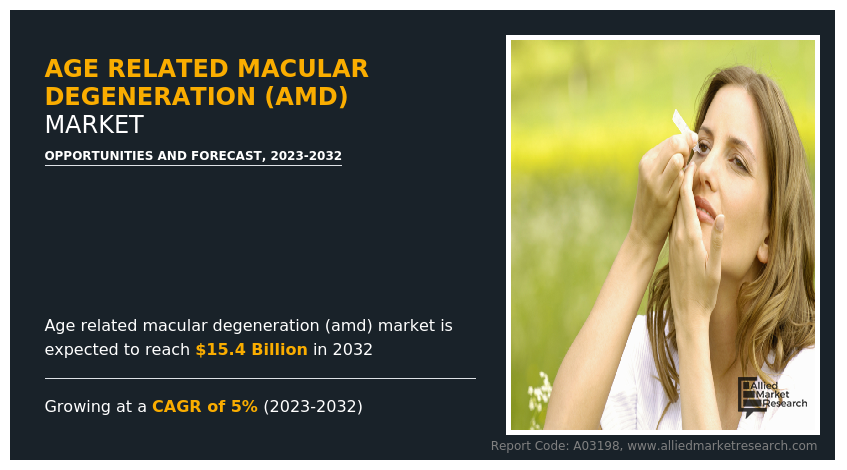
Market dynamics
The age-related macular degeneration (AMD) market trends are shaping the growth of the market. For instance rise in the adoption of age-related macular degeneration drugs (AMD) among the geriatric population suffering from age-related macular degeneration (AMD) drives the growth of the age-related macular degeneration (AMD) market size. For instance, according to the 2022 factsheet of World Health Organization, by 2030, 1 in 6 people in the world is projected to be aged 60 years or over, indicating a potential increase in the age-related macular degeneration (AMD) market size.
Age-Related Macular Degeneration (AMD) Market Forecast indicates steady growth with the expanding geriatric population, the demand for AMD drugs, and the development of new treatments. The market is projected to reach $15.4 billion by 2032, growing at a CAGR of 5% from 2023.
By 2050, the world population of people aged 60 years and older is expected to be 2.1 billion. The number of people aged 80 years or older is expected to reach 426 million by 2050. In addition, rise in the demand for age-related macular degeneration drugs for the treatment dry age-related macular degeneration (AMD) across the world further boost the growth of the age-related macular degeneration market.
Furthermore, age-related macular degeneration (AMD) market analysis suggests a significant demand for age-related macular degeneration drugs, driven by the rise in the prevalence of wet age-related macular degeneration (AMD) among the elderly population propel the growth of the market. For instance, according to the National Center of Biotechnology Information (NCBI) it was estimated that about 10% population in world suffers from wet age-related macular degeneration (AMD).
In addition, age-related macular degeneration (AMD) market share is expected to increase with the growing demand for age-related macular degeneration drugs and the rise in the number of product approvals for the treatment of wet AMD. For instance, in October 2021 Roche announced that the U.S. Food and Drug Administration (FDA) has approved Susvimo (ranibizumab injection) 100 mg/mL for intravitreal use via ocular implant for the treatment of people with neovascular or wet age-related macular degeneration (AMD).
In addition, age-related macular degeneration (AMD) market growth is fueled by increase in the number of pipeline drugs across the world for the treatment of dry age-related macular degeneration (AMD) drives the growth of the market. According to the World Health Organization age-related macular degeneration (AMD) is the leading cause of vision loss among the elderly population and affects 30–50 million individuals worldwide. Globally, nearly one in six vision loss occurs due to age-related macular degeneration (AMD).
Several pharmaceutical companies are actively participating in the age-related macular degeneration market to address the unmet medical needs. Currently, several manufacturers develop drugs for the treatment of age-related macular degeneration (AMD), and more than 10 age-related macular degeneration (AMD) drugs are in the pipeline at various stages of development. This in turn is expected to have a positive impact on the age-related macular degeneration (AMD) market share.
Potential drugs in phase III and II are ALK-001, Etamsylate, Zimura, Visomitin, Elamipretide, Risuteganib, GT005, GEM1003, RPESC-RPE-4W, MA09-hRPE, CPCB-RPE1, OpRegen, AAVCAGsCD59 and others. Presence of several drugs in pipeline with ideal drugs in late stage of development is thus expected to provide lucrative opportunities for the growth of age-related macular degeneration market.
However, high cost associated with age-related macular degeneration drugs is projected to impede the growth of AMD market in upcoming years. For instance, according to National Library of Medicine the average cost per person for the treatment of age-related macular degeneration (AMD) is $5,198.65. Thus, higher costs and insufficient insurance coverage for age-related macular degeneration (AMD) in some developing regions hinder the market growth across various geographies.
Covid Impact
Severe Acute Respiratory Syndrome Corona Virus-2 (SARS-CoV-2) is an infectious disease caused by the novel coronavirus (COVID-19). The World Health Organization (WHO) declared COVID-19 as a pandemic on March 11, 2020, and by 21 March 2023, 761.1 million people have been infected globally with over 6.9 million deaths.
Currently, available COVID-19 vaccines work by stimulating an immune response to the SARS-CoV-2 virus that causes COVID-19. World Health Organization (WHO) approved several vaccines for emergency use such as Comirnaty, Vaxzevria, Covovax, Novavax, Spikevax, Covishield, Covaxin, and Sinovac. Furthermore, according to World Health Organization (WHO), as of 20 March 2023, it was reported that a total of 13,259.9 million doses of vaccine have been administered.
The COVID-19 pandemic has had a significant impact on healthcare systems worldwide, including the treatment and management of chronic diseases such as age-related macular degeneration (AMD). During the pandemic, many people were unable to access routine eye care and treatment due to closures of clinics and reduced capacity of healthcare facilities. This delay in diagnosis and treatment of age-related macular degeneration (AMD) could lead to an increased risk of vision loss and potentially irreversible damage to the eyes.
The pandemic has also had an impact on the development and approval of new treatments for age-related macular degeneration (AMD) impacting the growth AMD market. Clinical trials and research studies were disrupted, and regulatory agencies were prioritizing COVID-19-related drugs and vaccines over other treatments. This may have delayed the development and approval of new drugs and therapies for AMD. Overall, the COVID-19 pandemic has had a significant impact on the age-related macular degeneration industry.
Segmental Overview
The age-related macular degeneration (AMD) market is segmented into drug type, disease type, distribution channels and region. On the basis of drug type, the market is categorized into aflibercept, ranibizumab and others. On the basis of disease type, the market is bifurcated into dry age-related macular degeneration (AMD) and wet age-related macular degeneration (AMD).
On the basis of distribution channels, the market is segmented into hospital pharmacy, retail pharmacy and online pharmacy. On the basis of region, the market is analyzed across North America (the U.S., Canada, and Mexico), Europe (Germany, France, the UK, Italy, Spain, and Rest of Europe), Asia-Pacific (Japan, China, Australia, India, South Korea, and Rest of Asia-Pacific), and LAMEA (Brazil, South Africa, Saudi Arabia, and Rest of LAMEA).
By drug type:
The market is categorized into aflibercept, ranibizumab, and others. The aflibercept segment dominated the global market in 2022, owing to rise in adoption of aflibercept drug across the world and increase in prevalence of age-related macular degeneration (AMD) among elderly population. For instance, according to a 2022 report by Center for Disease Control and Prevention, an estimated 19.8 million (12.6%) Americans aged 40 and older were living with age-related macular degeneration (AMD).
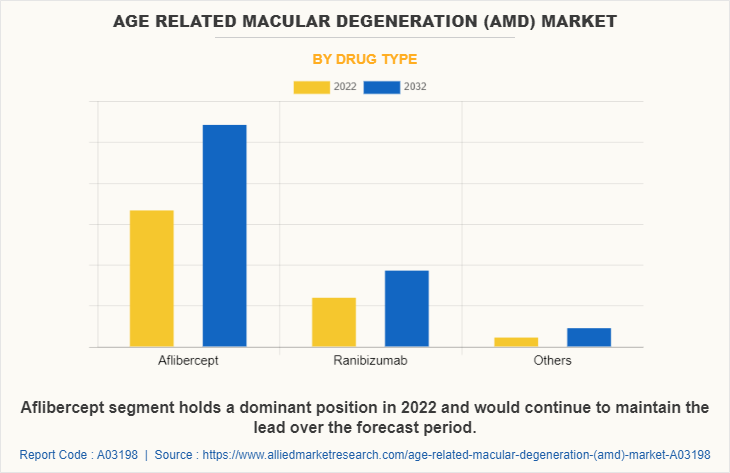
By disease type:
The market is bifurcated into dry age-related macular degeneration (AMD) and wet age-related macular degeneration (AMD). The wet age-related macular degeneration (AMD) segment dominated the global market in 2022, owing to rise in the prevalence of wet age-related macular degeneration (AMD) across the world.
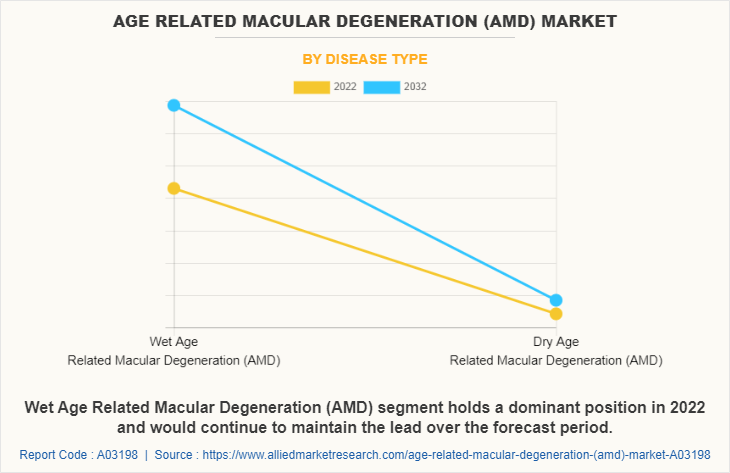
By distribution channel:
On the basis of distribution channel, the market is divided into hospital pharmacy, retail pharmacy and online pharmacy. Hospital pharmacy occupied highest share in 2022 owing to increase in sales of prescription age-related macular degeneration (AMD) drugs from hospital pharmacy drives the growth of the market.
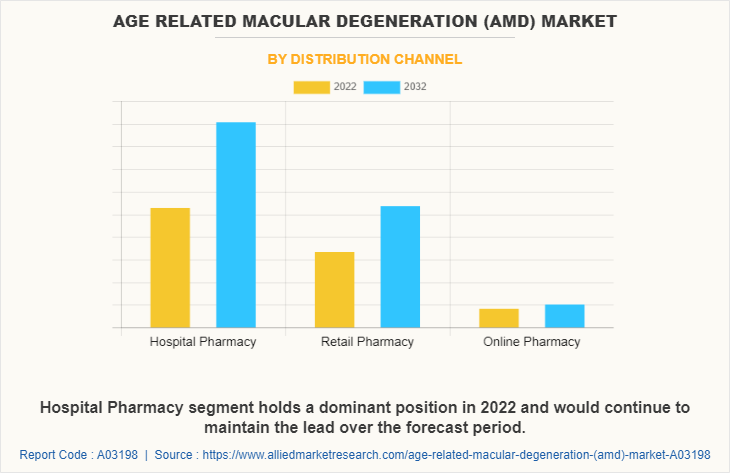
By region:
The age-related macular degeneration (AMD) market is analyzed across North America, Europe, Asia-Pacific, and LAMEA. North America accounted for a major share of the age-related macular degeneration (AMD) market in 2022 and is expected to maintain its dominance during the forecast period, owing to strong presence of several major players, such as, Biogen, Coherus Biosciences Inc, Apellis Pharmaceuticals and Bausch Health Companies Inc. and technological advancement in diagnostic methods.
In addition, rise in number of geriatric population in this region also contribute towards the growth of the market. Moreover, high purchasing power, and rise in awareness of age-related macular degeneration (AMD) is expected to drive market growth.
In addition, Asia-Pacific is expected to grow at the fastest rate during the forecast period, owing to increase in investments in development of treatment options for age-related macular degeneration and rise in number of key players, drive the growth of the market during the forecast period. In addition, favorable government policies are also contributing toward the growth of the market.
For instance, National Programme for Control of Blindness and Visual Impairment (NPCB&VI), an Indian Government initiative to reduce the prevalence of avoidable blindness. Refractive errors, corneal blindness, and childhood blindness, the program is equally focused on other eye diseases such as glaucoma, diabetic retinopathy, retinopathy of prematurity (ROP), age-related macular degeneration and others, Apart from cataracts.
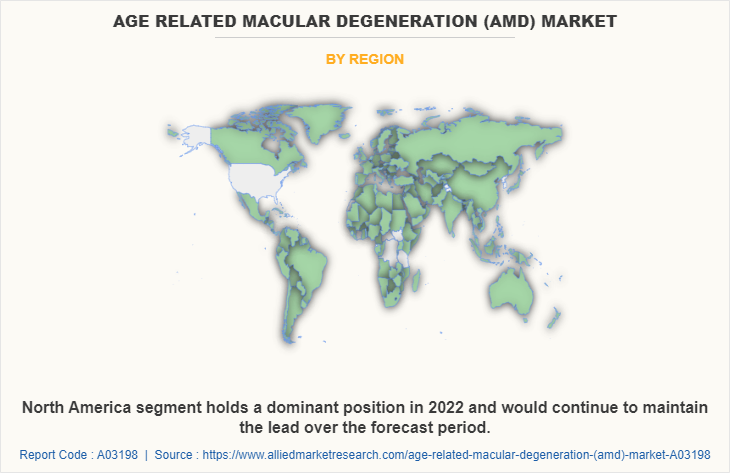
COMPETITION ANALYSIS
Competitive analysis and profiles of the major players in the age-related macular degeneration (AMD) market, such as Regeneron Pharmaceuticals Inc., Novartis AG, F. Hoffmann-La Roche Ltd, Biogen, Bayer AG, Bausch Health Companies Inc, Coherus Biosciences Inc, Sanofi, Apellis Pharmaceuticals and Ionis Pharmaceuticals, Inc . Major players have adopted product approval and product launch as key developmental strategies to improve the product portfolio of the age-related macular degeneration (AMD) market.
Some examples of product approval in the market
- In February 2020, Novartis announced that European Commission (EC) has approved Beovu (brolucizumab) injection for the treatment of wet age-related macular degeneration (AMD). Beovu is the first EC-approved anti-VEGF treatment to demonstrate superior resolution of retinal fluid (IRF/SRF).
- In September 2021, Samsung Bioepis Co., Ltd., and Biogen Inc. announced that the U.S. Food and Drug Administration (FDA) has approved Byooviz (ranibizumab-nuna), for the treatment of neovascular (wet) age-related macular degeneration (AMD.
- In February 2023, Apellis Pharmaceuticals, Inc. announced that the U.S. Food and Drug Administration (FDA) has approved SYFOVRE (pegcetacoplan injection) for the treatment of geographic atrophy (GA) secondary to age-related macular degeneration (AMD).
Key Benefits For Stakeholders
- This report provides a quantitative analysis of the market segments, current trends, estimations, and dynamics of the age related macular degeneration (amd) market analysis from 2022 to 2032 to identify the prevailing age-related macular degeneration (AMD) market opportunity.
- The market research is offered along with information related to key drivers, restraints, and opportunities.
- Porter's five forces analysis highlights the potency of buyers and suppliers to enable stakeholders make profit-oriented business decisions and strengthen their supplier-buyer network.
- In-depth analysis of the age related macular degeneration (amd) market segmentation assists to determine the prevailing market opportunities.
- Major countries in each region are mapped according to their revenue contribution to the global market.
- Market player positioning facilitates benchmarking and provides a clear understanding of the present position of the market players.
- The report includes the analysis of the regional as well as global age related macular degeneration (amd) market trends, key players, market segments, application areas, and market growth strategies.
Age Related Macular Degeneration (AMD) Market Report Highlights
| Aspects | Details |
| Market Size By 2032 | USD 15.4 billion |
| Growth Rate | CAGR of 5% |
| Forecast period | 2022 - 2032 |
| Report Pages | 251 |
| By Drug Type |
|
| By Disease Type |
|
| By Distribution Channel |
|
| By Region |
|
| Key Market Players | Ionis Pharmaceuticals, Inc., Apellis Pharmaceuticals Inc., Sanofi S.A., Bayer AG, Coherus Biosciences Inc, Bausch Health Companies Inc., F. Hoffmann-La Roche Ltd., Biogen, Novartis AG, Regeneron Pharmaceuticals Inc. |
Analyst Review
This section provides opinions of top level CXOs in the age-related macular degeneration market (AMD). The age-related macular degeneration market (AMD) has witnessed growth, owing to an increase in the incidence of age-related macular degeneration (AMD), and rise in the number of geriatric populations among the developing countries.?
According to the perspectives of CXOs, the global age-related macular degeneration market (AMD) is expected to witness a steady growth in the future. This is attributed to increase in the prevalence of age-related macular degeneration (AMD) and a rise in awareness regarding the potential benefits of age-related macular degeneration market (AMD) treatment. This has led to an increase in demand for age-related macular degeneration market (AMD) drugs across the globe. This is anticipated to fuel market growth during the forecast period. Furthermore, the surge in geriatric population that are susceptible to age-related macular degeneration market (AMD) further drives the growth of the market. However, However, high of age-related macular degeneration market (AMD) and side effects associated with age-related macular degeneration market (AMD) are anticipated to hamper the market growth in the upcoming years.?
North America is expected to witness the highest growth, in terms of revenue, owing to an increase in cases of age-related macular degeneration market (AMD), robust healthcare infrastructure, presence of key players, and rise in healthcare expenditure. However, Asia-Pacific is anticipated to witness notable growth, owing to increase in use of age-related macular degeneration market (AMD) drugs among aged population, rise in the number of geriatric population and increase in public–private investments in the healthcare sector.
The upcoming trends are increase in the geriatric population, the surge in demand for effective treatment options, and technological advancement.
The global Age-Related Macular Degeneration (AMD) market was valued at $9.4 billion in 2022
North America is the largest regional market for Age Related Macular Degeneration (AMD)
$15.41 billion is the estimated industry size of Age-Related Macular Degeneration (AMD) in 2032
Regeneron Pharmaceuticals Inc., Novartis AG, F. Hoffmann-La Roche Ltd, Biogen, Bayer AG, Bausch Health Companies Inc, Coherus Biosciences Inc, Sanofi, Apellis Pharmaceuticals and Ionis Pharmaceuticals, Inc are the top companies.
The 2023-2032 forecast period is considered in the market report
No, there is a value chain analysis provided in the report
10 Companies are profiled in Age-Related Macular Degeneration (AMD) Market
Loading Table Of Content...
Loading Research Methodology...



